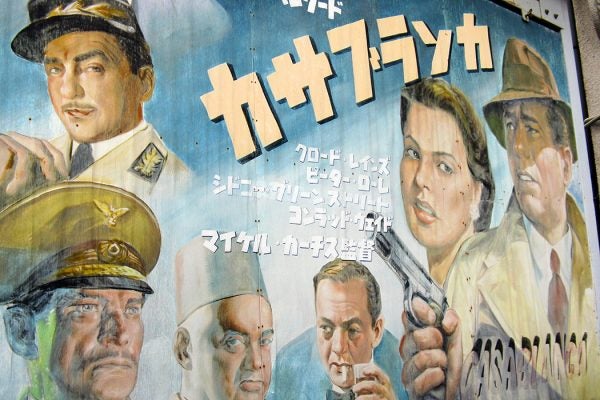In what is perhaps the most iconic Hollywood movie, an improbable American nightclub owner in Morocco retorts to the sinister Nazi, “there are certain sections of New York, Major, that I wouldn’t advise you to try to invade.” The stiletto-thin Nazi is played by Conrad Veidt, an anti-Nazi actor who actually left Germany to get his Jewish wife away from the Nazis. The American—who, when asked his nationality says, “I’m a drunkard”—is played by Humphrey Bogart. His club, Rick’s Café Américain, is where everyone goes in Casablanca, including the famed resistance leader Victor Laszlo and his wife Ilsa Lund, who just happens to be Rick’s former lover. Complications ensue…
Seventy-five years ago, when Casablanca premiered in a certain section of New York, the United States had already been at war for almost a year. The movie had originally been scheduled for release in the summer of 1943, but the Allied invasion of North Africa starting on November 8, 1942, inspired Warner Brothers to release the movie early, in time for Thanksgiving. Casablanca went on to win the 1942 Academy awards for Best Picture, Best Director, and Best Screenplay.
There are a lot of myths about the making of this movie, most notably that it was an “happy accident,” a haphazard production that just happened to cohere in a commercial success. Nonsense, argues Gary Green, who notes that the movie’s production was no messier than other famed films of the era, including Gone With the Wind (which ran through three directors before it was done).
Green concentrates on the role of director Michael Curtiz, who even with his best director Oscar usually gets less attention than the stellar acting roster. The actors included Ingrid Bergman, Claude Rains, Paul Henried, Sidney Greenstreet, Peter Lorre, and a host of colorful bit players, many of them European refugees. (In fact, the great majority of the actors were foreign-born). The crackling screenplay—by Howard Koch and twin brothers Julius and Philip Epstein—is also valorized as a stand-alone piece of art.
But Curtiz weaved it all together. Born Manó Kaminer in Budapest (when it was still part of Austria-Hungary), Curtiz was a Jew who apprenticed in the National Theater of Hungary and then the German film industry. He immigrated to the U.S., in 1926, anglicizing his Hungarian name, Mihály Kertész.
Green describes Curtiz as a forerunner of film noir, using the “German Expressionist style and its emphasis on mise en scene, particularly its use of murky lighting in which shadows and darkness take on potent meaning.” The corruptions of Casablanca, where life is cheaper than sand, foreshadow the mean American streets portrayed in the Hollywood noirs of the late 1940s and 1950s.
Green concentrates on the way the Curtiz composes the parallel triangulations of Rick/Ilsa/Laszlo and Rick/Renault/Strasser. Ilsa and Laszlo go off to continue the resistance, as do the seemingly cynical Rick and the roguishly corrupt Renault. Green writes, “Without the visual style brilliantly and deliberately composed by Michael Curtiz, the film could very easily have become just another Bogart picture, just another war story, just another romance.”

Instead, this is the apotheosis of Bogart pictures, war stories, and romances, (and bromances!), all merged together in the desert noir of Michael Curtiz. To this day, the American Film Institute consistently ranks Casablanca near the top of its list of best American films. Play it again, Sam. (Though that, of course, is not an actual line from the movie).







